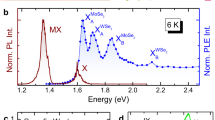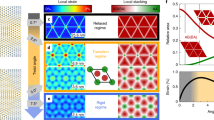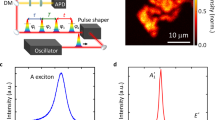Abstract
Moiré superlattices of two-dimensional heterostructures arose as a new platform to investigate emergent behaviour in quantum solids with unprecedented tunability. To glean insights into the physics of these systems, it is paramount to discover new probes of the moiré potential and moiré minibands, as well as their dependence on external tuning parameters. Hydrostatic pressure is a powerful control parameter, since it allows to continuously and reversibly enhance the moiré potential. Here we use high pressure to tune the minibands in a rotationally aligned MoS2/WSe2 moiré heterostructure, and show that their evolution can be probed via moiré phonons. The latter are Raman-inactive phonons from the individual layers that are activated by the moiré potential. Moiré phonons manifest themselves as satellite Raman peaks arising exclusively from the heterostructure region, increasing in intensity and frequency under applied pressure. Further theoretical analysis reveals that their scattering rate is directly connected to the moiré potential strength. By comparing the experimental and calculated pressure-induced enhancement, we obtain numerical estimates for the moiré potential amplitude and its pressure dependence. The present work establishes moiré phonons as a sensitive probe of the moiré potential as well as the electronic structures of moiré systems.
This is a preview of subscription content, access via your institution
Access options
Access Nature and 54 other Nature Portfolio journals
Get Nature+, our best-value online-access subscription
$29.99 / 30 days
cancel any time
Subscribe to this journal
Receive 12 print issues and online access
$259.00 per year
only $21.58 per issue
Buy this article
- Purchase on Springer Link
- Instant access to full article PDF
Prices may be subject to local taxes which are calculated during checkout




Similar content being viewed by others
Data availability
The datasets generated in the the current study are available via Zenodo at https://zenodo.org/record/7872421 (ref. 63). Source data are provided with this paper.
Code availability
DFT calculations were conducted with the SIESTA code (https://gitlab.com/siesta-project/siesta), which is released under the terms of the GPL open-source license. The proprietary Vienna ab initio simulation package code was used under license no. 5-488 (available at https://www.vasp.at/) for the periodic DFT phonon calculations together with the Phonopy software. Phonopy is an open-source package for phonon calculations at harmonic and quasi-harmonic levels, which is released under the terms of the BSD license and is available at https://phonopy.github.io/phonopy. An implementation of the zone-folding computation is available from the corresponding authors upon reasonable request.
References
Wu, F., Lovorn, T., Tutuc, E. & MacDonald, A. H. Hubbard model physics in transition metal dichalcogenide moiré bands. Phys. Rev. Lett. 121, 026402 (2018).
Magorrian, S. J. et al. Multifaceted moiré superlattice physics in twisted WSe2 bilayers. Phys. Rev. B 104, 125440 (2021).
Cao, Y. et al. Unconventional superconductivity in magic-angle graphene superlattices. Nature 556, 43–50 (2018).
Wang, L. et al. Correlated electronic phases in twisted bilayer transition metal dichalcogenides. Nat. Mater. 19, 861–866 (2020).
Sharpe, A. L. et al. Emergent ferromagnetism near three-quarters filling in twisted bilayer graphene. Science 365, 605–608 (2019).
Tang, Y. et al. Simulation of Hubbard model physics in WSe2/WS2 moiré superlattices. Nature 579, 353–358 (2020).
Xu, Y. et al. Correlated insulating states at fractional fillings of moiré superlattices. Nature 587, 214–218 (2020).
Yankowitz, M. et al. Tuning superconductivity in twisted bilayer graphene. Science 363, 1059–1064 (2019).
Gao, Y. et al. Band engineering of large-twist-angle graphene/h-BN moiré superlattices with pressure. Phys. Rev. Lett. 125, 226403 (2020).
Zhang, C. et al. Interlayer couplings, moiré patterns, and 2D electronic superlattices in MoS2/WSe2 hetero-bilayers. Sci. Adv. 3, e1601459 (2017).
Utama, M. et al. Visualization of the flat electronic band in twisted bilayer graphene near the magic angle twist. Nat. Phys. 17, 184–188 (2021).
Righi, A. et al. Graphene moiré patterns observed by Umklapp double-resonance Raman scattering. Phys. Rev. B 84, 241409 (2011).
Carozo, V. et al. Raman signature of graphene superlattices. Nano Lett. 11, 4527–4534 (2011).
Jorio, A. & Cançado, L. G. Raman spectroscopy of twisted bilayer graphene. Solid State Commun. 175, 3–12 (2013).
Eliel, G. et al. Intralayer and interlayer electron–phonon interactions in twisted graphene heterostructures. Nat. Commun. 9, 1221 (2018).
Lin, M.-L. et al. Moiré phonons in twisted bilayer MoS2. ACS Nano 12, 8770–8780 (2018).
Parzefall, P. et al. Moiré phonons in twisted MoSe2–WSe2 heterobilayers and their correlation with interlayer excitons. 2D Mater. 8, 035030 (2021).
Lin, K.-Q. et al. Large-scale mapping of moiré superlattices by hyperspectral Raman imaging. Adv. Mater. 33, 2008333 (2021).
Enaldiev, V. V., Ferreira, F., Magorrian, S. J. & Fal’ko, V. I. Piezoelectric networks and ferroelectric domains in twistronic superlattices in WS2/MoS2 and WSe2/MoSe2 bilayers. 2D Mater. 8, 025030 (2021).
Liu, K. et al. Evolution of interlayer coupling in twisted molybdenum disulfide bilayers. Nat. Commun. 5, 4966 (2014).
Tateiwa, N. & Haga, Y. Evaluations of pressure-transmitting media for cryogenic experiments with diamond anvil cell. Rev. Sci. Instrum. 80, 123901 (2009).
Feng, Y., Jaramillo, R., Wang, J., Ren, Y. & Rosenbaum, T. Invited article: high-pressure techniques for condensed matter physics at low temperature. Rev. Sci. Instrum. 81, 041301 (2010).
Nayak, A. P. et al. Pressure-dependent optical and vibrational properties of monolayer molybdenum disulfide. Nano Lett. 15, 346–353 (2015).
Machon, D. et al. Raman scattering studies of graphene under high pressure. J. Raman Spectrosc. 49, 121–129 (2018).
Alencar, R. S. et al. Atomic-layered MoS2 on SiO2 under high pressure: bimodal adhesion and biaxial strain effects. Phys. Rev. Mater. 1, 024002 (2017).
Chiu, M.-H. et al. Spectroscopic signatures for interlayer coupling in MoS2–WSe2 van der Waals stacking. ACS Nano 8, 9649–9656 (2014).
Kim, J. et al. Anomalous optical excitations from arrays of whirlpooled lattice distortions in moiré superlattices. Nat. Mater. 21, 890–895 (2022).
Gong, C. et al. Band alignment of two-dimensional transition metal dichalcogenides: application in tunnel field effect transistors. Appl. Phys. Lett. 103, 053513 (2013).
Kang, J., Tongay, S., Zhou, J., Li, J. & Wu, J. Band offsets and heterostructures of two-dimensional semiconductors. Appl. Phys. Lett. 102, 012111 (2013).
Thygesen, K. S. Calculating excitons, plasmons, and quasiparticles in 2D materials and van der Waals heterostructures. 2D Mater. 4, 022004 (2017).
Alexeev, E. M. et al. Resonantly hybridized excitons in moiré superlattices in van der waals heterostructures. Nature 567, 81–86 (2019).
Ruiz-Tijerina, D. A. & Fal’ko, V. I. Interlayer hybridization and moiré superlattice minibands for electrons and excitons in heterobilayers of transition-metal dichalcogenides. Phys. Rev. B 99, 125424 (2019).
McDonnell, L. P. et al. Superposition of intra- and inter-layer excitons in twistronic MoSe2/WSe2 bilayers probed by resonant Raman scattering. 2D Mater. 8, 035009 (2021).
Ferreira, F., Magorrian, S. J., Enaldiev, V. V., Ruiz-Tijerina, D. A. & Fal’ko, V. I. Band energy landscapes in twisted homobilayers of transition metal dichalcogenides. Appl. Phys. Lett. 118, 241602 (2021).
Selig, M. et al. Excitonic linewidth and coherence lifetime in monolayer transition metal dichalcogenides. Nat. Commun. 7, 13279 (2016).
Enaldiev, V., Ferreira, F., Magorrian, S. & Fal’ko, V. I. Piezoelectric networks and ferroelectric domains in twistronic superlattices in WS2/MoS2 and WSe2/MoSe2 bilayers. 2D Mater. 8, 025030 (2021).
Carvalho, B. R. et al. Intervalley scattering by acoustic phonons in two-dimensional MoS2 revealed by double-resonance Raman spectroscopy. Nat. Commun. 8, 14670 (2017).
Pimenta Martins, L. G. et al. Electronic band tuning and multivalley Raman scattering in monolayer transition metal dichalcogenides at high pressures. ACS Nano 16, 8064–8075 (2022).
Park, J.-H. et al. Synthesis of high-performance monolayer molybdenum disulfide at low temperature. Small Methods 5, 2000720 (2021).
Arora, A. et al. Excitonic resonances in thin films of WSe2: from monolayer to bulk material. Nanoscale 7, 10421–10429 (2015).
Vaquero, D. et al. Excitons, trions and Rydberg states in monolayer MoS2 revealed by low-temperature photocurrent spectroscopy. Commun. Phys. 3, 194 (2020).
Paradisanos, I. et al. Controlling interlayer excitons in MoS2 layers grown by chemical vapor deposition. Nat. Commun. 11, 2391 (2020).
Wang, J. I.-J. et al. Electronic transport of encapsulated graphene and WSe2 devices fabricated by pick-up of prepatterned hBN. Nano Lett. 15, 1898–1903 (2015).
Martins, L. G. P. et al. Hard, transparent, sp3-containing 2D phase formed from few-layer graphene under compression. Carbon 173, 744–757 (2021).
Karni, O. et al. Infrared interlayer exciton emission in MoS2/WSe2 heterostructures. Phys. Rev. Lett. 123, 247402 (2019).
Kozawa, D. et al. Photocarrier relaxation pathway in two-dimensional semiconducting transition metal dichalcogenides. Nat. Commun. 5, 4543 (2014).
Viner, J. J. S. et al. Excited Rydberg states in MoSe2/WSe2 heterostructures. 2D Mater. 8, 035047 (2021).
Pisoni, R. et al. Interactions and magnetotransport through spin-valley coupled Landau levels in monolayer MoS2. Phys. Rev. Lett. 121, 247701 (2018).
Nguyen, P. V. et al. Visualizing electrostatic gating effects in two-dimensional heterostructures. Nature 572, 220–223 (2019).
Gustafsson, M. V. et al. Ambipolar Landau levels and strong band-selective carrier interactions in monolayer WSe2. Nat. Mater. 17, 411–415 (2018).
Hohenberg, P. & Kohn, W. Inhomogeneous electron gas. Phys. Rev. 136, B864 (1964).
Kohn, W. & Sham, L. J. Self-consistent equations including exchange and correlation effects. Phys. Rev. 140, A1133–A1138 (1965).
Soler, J. M. et al. The SIESTA method for ab initio order-N materials simulation. J. Phys.: Condens. Matter 14, 2745 (2002).
Troullier, N. & Martins, J. L. Efficient pseudopotentials for plane-wave calculations. Phys. Rev. B 43, 1993–2006 (1991).
Kleinman, L. & Bylander, D. Efficacious form for model pseudopotentials. Phys. Rev. Lett. 48, 1425 (1982).
Perdew, J. P., Burke, K. & Ernzerhof, M. Generalized gradient approximation made simple. Phys. Rev. Lett. 77, 3865 (1996).
Moreno, J. & Soler, J. M. Optimal meshes for integrals in real- and reciprocal-space unit cells. Phys. Rev. B 45, 13891–13898 (1992).
Blöchl, P. E. Projector augmented-wave method. Phys. Rev. B 50, 17953–17979 (1994).
Kresse, G. & Joubert, D. From ultrasoft pseudopotentials to the projector augmented-wave method. Phys. Rev. B 59, 1758–1775 (1999).
Kresse, G. & Furthmüller, J. Efficient iterative schemes for ab initio total-energy calculations using a plane-wave basis set. Phys. Rev. B 54, 11169–11186 (1996).
Kresse, G. & Furthmüller, J. Efficiency of ab-initio total energy calculations for metals and semiconductors using a plane-wave basis set. Comput. Mater. Sci. 6, 15–50 (1996).
Togo, A. & Tanaka, I. First principles phonon calculations in materials science. Scr. Mater. 108, 1–5 (2015).
Pimenta Martins, L. G. et al. Dataset for pressure-tuning of minibands in MoS2/WSe2 heterostructures revealed by moiré phonons. Zenodo https://doi.org/10.5281/zenodo.7872421 (2023).
Acknowledgements
L.G.P.M., J.-H.P. and J.K. acknowledge support from the MURI project by the US Army Research Office (ARO) under grant no. W911NF-18-1-0431. D.A.R.-T. acknowledges funding from PAPIIT-DGAPA-UNAM grant IA106523, and CONACyT grant 1564464. R.C. acknowledges support from the National Science Foundation under grant no. 1751739 and the STC Center for Integrated Quantum Materials, NSF, grant no. DMR-1231319. L.G.P.M. and J.K. acknowledge support from CNPq under the program Ciência sem Fronteiras (206251/2014-9). L.G.C. acknowledges support from CNPq through grant 309537/2019-3. M.S.C.M. and M.J.S.M. acknowledge financial support from CNPq, FAPEMIG and INCT-Nanocarbono. M.J.S.M. acknowledges support from the Universidade Federal de Ouro Preto (UFOP). We also acknowledge computational support from CESUP-UFRGS. This work was performed in part at the Center for Nanoscale Systems (CNS), a member of the National Nanotechnology Coordinated Infrastructure Network (NNCI), which is supported by the National Science Foundation under NSF award no. 1541959.
Author information
Authors and Affiliations
Contributions
L.G.P.M., J.K. and R.C. conceived the project. J.K. and R.C. supervised the project. D.A.R.-T. proposed the effective model for the pressure-dependent moiré potential, and carried out the zone-folding analysis and Raman rate computations. L.G.P.M., J.-H.P., Q.S. and A.-Y.L. prepared the TMD samples on a silicon substrate. L.G.P.M. and C.A.O. carried out the high-pressure Raman and PL experiments, and they analysed the experimental data. D.A.R.-T., L.G.P.M. and L.G.C. developed the proposed scattering mechanisms for moiré phonons. M.J.S.M., M.S.C.M. and P.V. carried out the DFT calculations. L.G.P.M., D.A.R.-T., J.K. and R.C. wrote the manuscript. All authors contributed to the scientific discussions and data interpretation.
Corresponding authors
Ethics declarations
Competing interests
The authors declare no competing interests.
Peer review
Peer review information
Nature Nanotechnology thanks Christian Schüller, and the other, anonymous, reviewer(s) for their contribution to the peer review of this work.
Additional information
Publisher’s note Springer Nature remains neutral with regard to jurisdictional claims in published maps and institutional affiliations.
Extended data
Extended Data Fig. 1 Raman frequencies as a function of pressure, measured both in the heterostructure and in the individual layers.
a A’1 of MoS2. b E’ of MoS2. c nearly-degenerate E’ and A’1 modes of WSe2.
Extended Data Fig. 2 Raman spectra of WSe2, MoS2, and MoS2/WSe2 at increasing pressures, zoomed-in the M3 peak spectral region.
The MoS2 M3 moiré phonon Raman peak is downshifted with respect to the MoS2 E’ peak. Its intensity increases with increasing pressure. The pressure is indicated at the top right corner of each panel.
Extended Data Fig. 3 Optical image of loaded sample inside of the DAC.
Regions 1, 2 and 3, corresponding to WSe2 monolayer, MoS2 monolayer and a rotationally-aligned MoS2/WSe2 heterostructure, respectively. During the loading process, the other two MoS2/WSe2 heterostructures, indicated by the red arrows, got partially damaged. Image taken with a 650 nm edge filter to enhance the optical contrast.
Supplementary information
Supplementary Information
Supplementary Sections 1–5, Figs. 1–5 and discussion.
Source data
Source Data Fig. 1
Unprocessed Raman data shown in Fig. 1d,e.
Source Data Fig. 2
Experimental and fitting data points for Fig. 2a–d, and unprocessed polarized Raman data shown in Fig. 2e.
Source Data Fig. 4
Experimental and fitting data points for Fig. 4a,b.
Rights and permissions
Springer Nature or its licensor (e.g. a society or other partner) holds exclusive rights to this article under a publishing agreement with the author(s) or other rightsholder(s); author self-archiving of the accepted manuscript version of this article is solely governed by the terms of such publishing agreement and applicable law.
About this article
Cite this article
Pimenta Martins, L.G., Ruiz-Tijerina, D.A., Occhialini, C.A. et al. Pressure tuning of minibands in MoS2/WSe2 heterostructures revealed by moiré phonons. Nat. Nanotechnol. 18, 1147–1153 (2023). https://doi.org/10.1038/s41565-023-01413-3
Received:
Accepted:
Published:
Issue Date:
DOI: https://doi.org/10.1038/s41565-023-01413-3
This article is cited by
-
Engineering interlayer hybridization in van der Waals bilayers
Nature Reviews Materials (2024)



